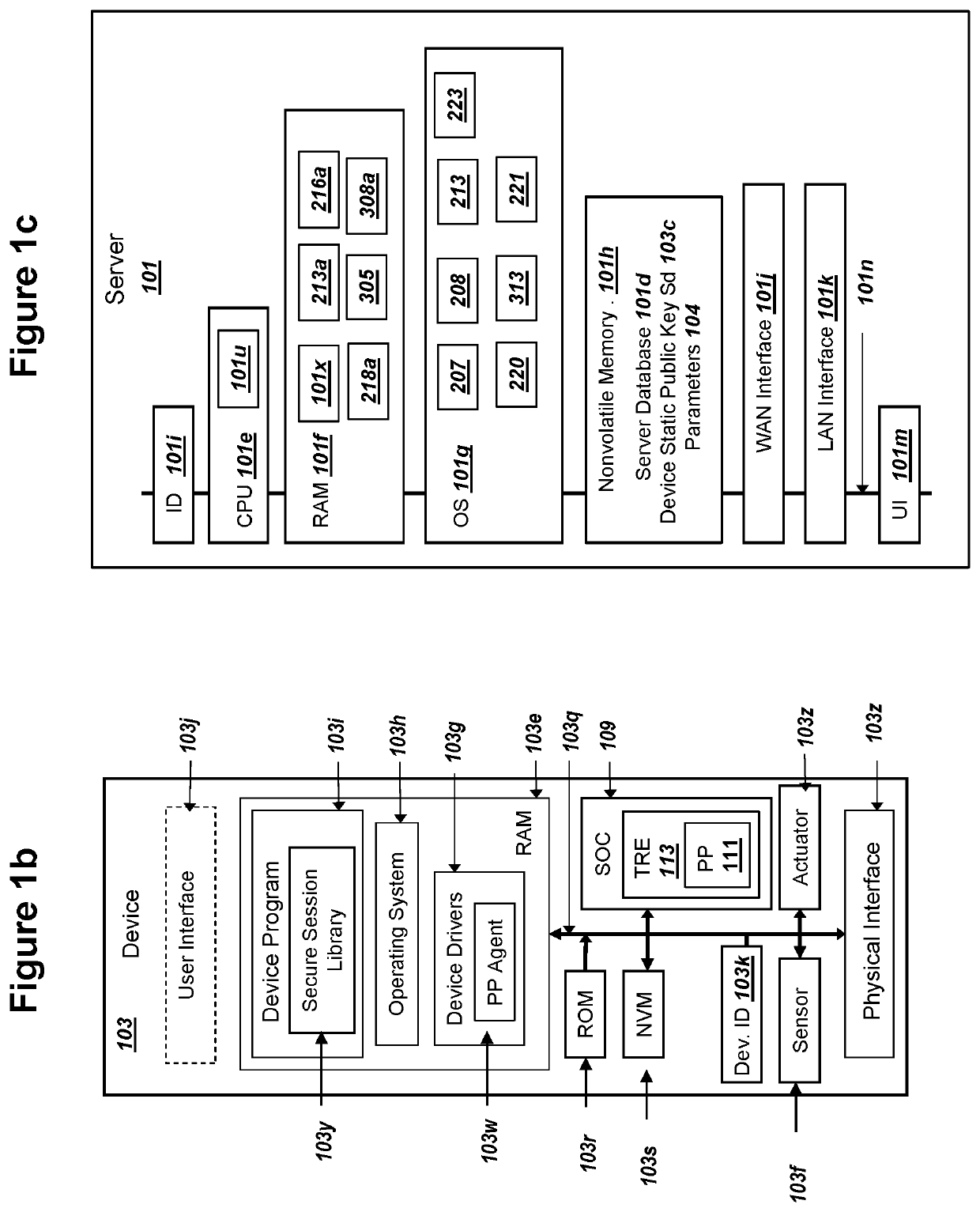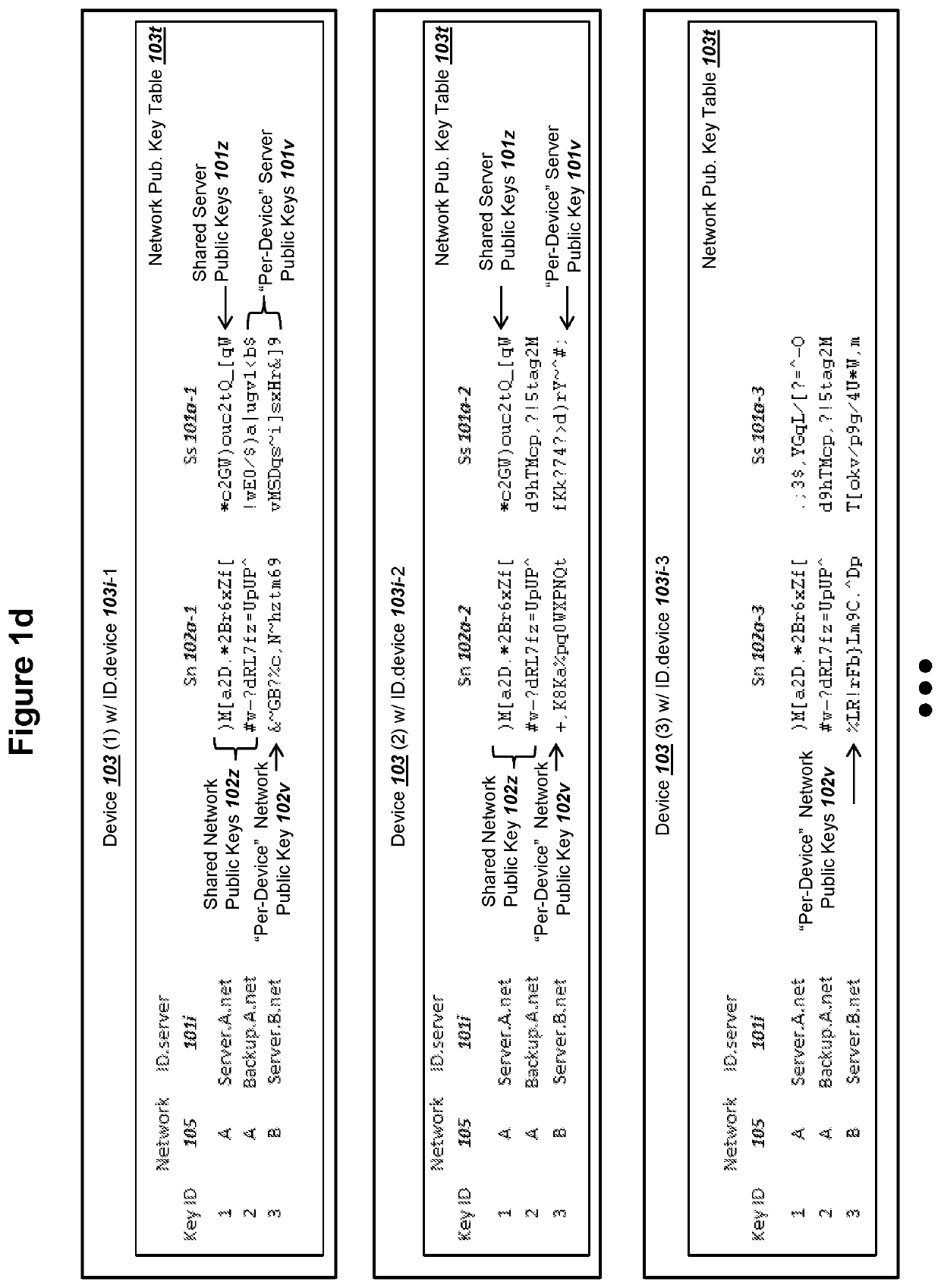Mutually authenticated ecdhe key exchange for a device and a network using multiple pki key pairs
a technology network, applied in the direction of multi-key/algorithm usage, public key for secure communication, digital transmission, etc., can solve the problems of ecdhe being susceptible to “man, use of ecdhe key exchange, and ) being subject to greater security risks
- Summary
- Abstract
- Description
- Claims
- Application Information
AI Technical Summary
Benefits of technology
Problems solved by technology
Method used
Image
Examples
first embodiment
[0168]A first embodiment for selecting key server 102 in a step 212 could comprise server 101 selecting the same key server 102 for all keys Ed 103a from all devices 103. For example, for this first method, server 101 could listen or operate on (i) a specific IP address and port number or (ii) with a specific DNS name or URL in step 201b, where the use if (i) or (ii) could be specified or associated with network static public key Sn 102a. As mentioned above for a step 203, device 103 can select the address of server 101 using the server address or name of server 101 recorded with Sn 102a (possibly from a table 103t in FIG. 1c). Server 101 could determine that all messages 299 received using (i) or (ii) are associated with a specific key server 102, where the key server 102 records the network static private key sn 102b corresponding to the network static public key Sn 102a recorded by the device 103.
[0169]A second embodiment of a step 212 for selecting key server 102 of received mes...
third embodiment
[0170]A secure hash value over a unique key 102v or unique key 101v could be used as well to determine a key server 102, where a server database 101d could include tables that map the unique secure hash value to a key server 102. As described above for a message 299, the message 299 can optionally include unique identifying information for device 103, and server 101 using database 101d could include a table to map any of (i), (ii), and (iii) in this paragraph to key server 102. For this third embodiment of a step 212, server 101 could conduct a query of server database 101d to select the key server 102 for device 103 using ID.device 103i.
fourth embodiment
[0171]A fourth embodiment for a step 212 to select a key server 102 for received message 299 could comprise using the subset of cryptographic parameters 104a from a step 210a. Server 101 could record that a first subset of cryptographic parameters 104a are associated with a first key server 102, and a second subset of cryptographic parameters 104a are associated with a second key server 102, etc. Other possibilities exist as well for server 101 to conduct a step 212 to select a key server 102 using data in a message 299 without departing from the scope of the present disclosure. For embodiments depicted and described in connection with FIG. 4 below, where a second key server 102x also records server static private key ss 101b, then server 101 could use a step 212 as well for selecting the second key server 102x in order to obtain point X2218a (as depicted and described in FIG. 4a).
[0172]After selecting key server 102 in a step 212, server 101 can then conduct an EC point addition st...
PUM
 Login to View More
Login to View More Abstract
Description
Claims
Application Information
 Login to View More
Login to View More - R&D
- Intellectual Property
- Life Sciences
- Materials
- Tech Scout
- Unparalleled Data Quality
- Higher Quality Content
- 60% Fewer Hallucinations
Browse by: Latest US Patents, China's latest patents, Technical Efficacy Thesaurus, Application Domain, Technology Topic, Popular Technical Reports.
© 2025 PatSnap. All rights reserved.Legal|Privacy policy|Modern Slavery Act Transparency Statement|Sitemap|About US| Contact US: help@patsnap.com



